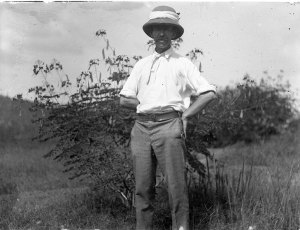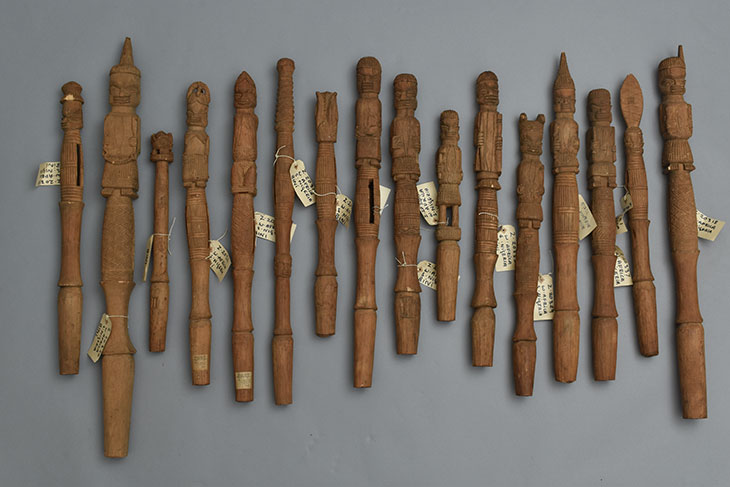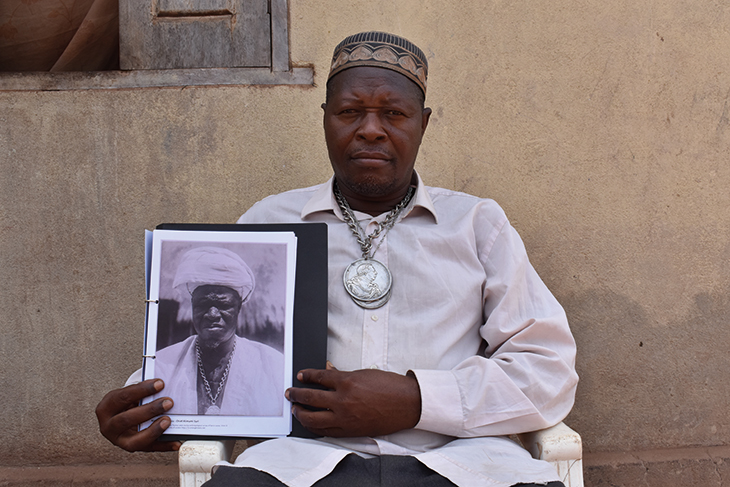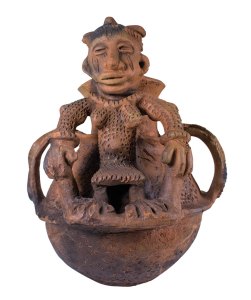The Rhodes Must Fall and Black Lives Matter movements have had a profound impact in the world of museums, and not least in museums of world cultures. While they have given new impetus to attempts to decolonise displays and institutional practices, press attention has inevitably focused on renewed debates about the restitution of collections. In the UK, for example, the demand for the return of treasures looted during the infamous sacking of Benin City in 1897 is a cause célèbre; there is a growing acknowledgement that trophies of colonial violence sit uneasily in institutions dedicated to serving the public good.
Notorious cases of colonial looting, where the ethical case for returning collections is surely least contestable, obscure the fact that the vast majority of collections assembled during the colonial era are of a rather different nature. Much more typical are the kinds of collections formed in the early 20th century by Northcote Thomas (1868–1936), the first anthropologist employed by the British Colonial Office, in a series of surveys in ‘British’ West Africa.

Northcote Thomas, Government Anthropologist, photographed probably by his assistant Corporal Nimahan, in southern Nigeria, 1909–10. Image: Royal Anthropological Institute
Between 1909 and 1915, Thomas led four surveys, three in what was then the Protectorate of Southern Nigeria and one in the Protectorate of Sierra Leone. (During his first tour, he spent several months based in Benin City.) Over six years, Thomas and his assistants travelled widely, photographing and documenting many aspects of social and cultural life; recording songs and stories on wax phonograph cylinders; conducting linguistic research; assembling botanical specimens; and, indeed, making extensive collections of artefacts.
Only a fraction of the research was published in Thomas’s multi-volume reports, and little of the material gathered has ever been on public display. Recently, however, the archives and collections of these surveys have been the focus of a four-year research and public engagement programme – a collaborative endeavour, which I have had the privilege of leading – and they are now the subject of a new exhibition at the Museum of Archaeology and Anthropology (MAA) in Cambridge.
In contrast with the ‘court arts’ pillaged from palaces and shrines in Benin City in 1897 (examples of which are on display elsewhere in the MAA), the collections assembled by Thomas a decade or so later include many more mundane items: baskets and fish traps; cooking utensils and pottery vessels; children’s toys and musical instruments; as well as charms, masks and carved figurines. They were intended to be a representative sample of local material culture and decorative arts. We know from surviving records that they were purchased at markets and from individuals – and that Thomas paid artists to make things expressly for collection.
Thomas initially offered the collections from his first tour to the British Museum, but the head of the ethnology division, C.H. Read, rejected them, stating in a letter: ‘I am by no means sure that I want these modern things made to order as it were.’ As a consequence, they eventually came to Cambridge. It is interesting to note that, today, the purchase of ‘modern things’ (rather than antiquities) at market and the direct commissioning of works from artists and makers are regarded as the most ethical forms of museum acquisition.

Selection of ukhurhe rattle staffs commissioned to be made by Northcote Thomas in Benin City, Nigeria, in 1909. Photo: George Agbo/Museum of Archaeology & Anthropology, University of Cambridge.
This is not to say that these archives and collections are not entangled in the ideologies and injustices of colonialism. As the material legacies of official surveys instigated by the Colonial Office and intended to support the effective implementation of indirect British rule, these items are every bit as enmeshed in colonial power relations as the looted treasures of Benin. However, they also pose more complex, ambiguous questions. They are, to use an anthropological trope, ‘good to think with’.
Recently, some critics have rejected terms such as ‘entanglement’ that have been used to describe colonial relations. Its invocation of complexity has, they argue, disguised the true nature of European colonial conquest and its racist ideologies. Rather than abandon the term, I suggest that it would be better to repoliticise it. This is reflected in the title of the exhibition – ‘[Re:]Entanglements: Colonial Collections in Decolonial Times’ (22 June–17 April 2022). Colonialism was not a storybook contest between good and evil. It was complex and contradictory. Attending to the more ambiguous status of these anthropological collections helps us to consider what other forms of violence were at work in colonial encounters, and in what other ways museums – and disciplines such as anthropology – were implicated in these more insidious injustices.
Most importantly, revisiting these archives demands that, from our respective positions, we re-entangle ourselves in these issues. Rather than treating colonial collections as toxic relics of an unsettling past and sealing them away in the museum’s vaults, we need to bring them into the light and confront the difficult questions they pose. Just as these materials remain troubling presences in our cultural institutions, so they remind us that other uncomfortable legacies of colonialism are still with us today. Colonial collections are like Stolpersteine, tripping us up should we forget that coloniality is not only a thing of the past.

Paramount Chief Kandeh Sori Kakanday III of Samaya, Sierra Leone, holding a photograph of his ancestor, Chief Almamy Suri Kandeh, taken by Northcote Thomas in 1914. Photo: Paul Basu
Can such collections also contribute to a process of decolonisation in the present? Over the course of our research we have retraced many of Northcote Thomas’s survey itineraries, sharing copies of the historical photographs and sound recordings with the communities whose heritage they record. We have invited Nigerian and Sierra Leonean artists to respond to and reappropriate these archives. We have used the collections to open up conversations about colonial histories and ongoing conditions of coloniality with diverse publics in West Africa, the UK and beyond. Collaboratively curated shows in Benin City, in Lagos, and at the University of Nigeria, Nsukka – as well as the current show in Cambridge – have presented some of these creative experiments in activating the archive.
At the MAA, we have subverted the conventions of ethnographic display, and mined the archives of Northcote Thomas’s anthropological surveys in search of material metaphors that speak more powerfully than words of the colonial violences in which they are entangled. Into the exhibition’s displays are knotted, sometimes literally, damaged images, fractured glass-plate negatives, mirror frames without mirrors, broken pots and dislocated voices.

Shrine vessel for the Edo deity Olokun, collected by Northcote Thomas in Benin City in 1909. Museum of Archaeology and Anthropology, Cambridge. Photo: Carmen Vida/UCL Institute of Archaeology
But there are also attempts at repair. At the centre of the exhibition is a highly decorated pot purchased by Thomas in Benin City in 1909. Pots such as this were placed on shrines of Olokun, an Edo deity associated with water and fertility. The pot was shattered, most likely when it was shipped from Nigeria to Britain. It was repaired at the MAA, but in a manner that left it fragile and unstable. For the exhibition it was decided to dismantle the pot into its fragments – there were nearly 90 shards – and reconstruct it once more, using current conservation techniques and materials. As with the ‘poetic mends’ of Japanese kintsugi, however, care was taken to make the repairs visible, so as not to disguise its history of breakage.
‘[Re:]Entanglements: Colonial Collections in Decolonial Times’ is at the Museum of Archaeology and Anthropology, Cambridge, until 17 April 2022. (re-entanglements.net).
From the July/August 2021 issue of Apollo. Preview and subscribe here.

What should happen to colonial collections that weren’t looted?
Installation view of ‘Re-Entanglements: Colonial Collections in Decolonial Times’ at the Museum of Archaeology and Anthropology in Cambridge.
Share
The Rhodes Must Fall and Black Lives Matter movements have had a profound impact in the world of museums, and not least in museums of world cultures. While they have given new impetus to attempts to decolonise displays and institutional practices, press attention has inevitably focused on renewed debates about the restitution of collections. In the UK, for example, the demand for the return of treasures looted during the infamous sacking of Benin City in 1897 is a cause célèbre; there is a growing acknowledgement that trophies of colonial violence sit uneasily in institutions dedicated to serving the public good.
Notorious cases of colonial looting, where the ethical case for returning collections is surely least contestable, obscure the fact that the vast majority of collections assembled during the colonial era are of a rather different nature. Much more typical are the kinds of collections formed in the early 20th century by Northcote Thomas (1868–1936), the first anthropologist employed by the British Colonial Office, in a series of surveys in ‘British’ West Africa.
Northcote Thomas, Government Anthropologist, photographed probably by his assistant Corporal Nimahan, in southern Nigeria, 1909–10. Image: Royal Anthropological Institute
Between 1909 and 1915, Thomas led four surveys, three in what was then the Protectorate of Southern Nigeria and one in the Protectorate of Sierra Leone. (During his first tour, he spent several months based in Benin City.) Over six years, Thomas and his assistants travelled widely, photographing and documenting many aspects of social and cultural life; recording songs and stories on wax phonograph cylinders; conducting linguistic research; assembling botanical specimens; and, indeed, making extensive collections of artefacts.
Only a fraction of the research was published in Thomas’s multi-volume reports, and little of the material gathered has ever been on public display. Recently, however, the archives and collections of these surveys have been the focus of a four-year research and public engagement programme – a collaborative endeavour, which I have had the privilege of leading – and they are now the subject of a new exhibition at the Museum of Archaeology and Anthropology (MAA) in Cambridge.
In contrast with the ‘court arts’ pillaged from palaces and shrines in Benin City in 1897 (examples of which are on display elsewhere in the MAA), the collections assembled by Thomas a decade or so later include many more mundane items: baskets and fish traps; cooking utensils and pottery vessels; children’s toys and musical instruments; as well as charms, masks and carved figurines. They were intended to be a representative sample of local material culture and decorative arts. We know from surviving records that they were purchased at markets and from individuals – and that Thomas paid artists to make things expressly for collection.
Thomas initially offered the collections from his first tour to the British Museum, but the head of the ethnology division, C.H. Read, rejected them, stating in a letter: ‘I am by no means sure that I want these modern things made to order as it were.’ As a consequence, they eventually came to Cambridge. It is interesting to note that, today, the purchase of ‘modern things’ (rather than antiquities) at market and the direct commissioning of works from artists and makers are regarded as the most ethical forms of museum acquisition.
Selection of ukhurhe rattle staffs commissioned to be made by Northcote Thomas in Benin City, Nigeria, in 1909. Photo: George Agbo/Museum of Archaeology & Anthropology, University of Cambridge.
This is not to say that these archives and collections are not entangled in the ideologies and injustices of colonialism. As the material legacies of official surveys instigated by the Colonial Office and intended to support the effective implementation of indirect British rule, these items are every bit as enmeshed in colonial power relations as the looted treasures of Benin. However, they also pose more complex, ambiguous questions. They are, to use an anthropological trope, ‘good to think with’.
Recently, some critics have rejected terms such as ‘entanglement’ that have been used to describe colonial relations. Its invocation of complexity has, they argue, disguised the true nature of European colonial conquest and its racist ideologies. Rather than abandon the term, I suggest that it would be better to repoliticise it. This is reflected in the title of the exhibition – ‘[Re:]Entanglements: Colonial Collections in Decolonial Times’ (22 June–17 April 2022). Colonialism was not a storybook contest between good and evil. It was complex and contradictory. Attending to the more ambiguous status of these anthropological collections helps us to consider what other forms of violence were at work in colonial encounters, and in what other ways museums – and disciplines such as anthropology – were implicated in these more insidious injustices.
Most importantly, revisiting these archives demands that, from our respective positions, we re-entangle ourselves in these issues. Rather than treating colonial collections as toxic relics of an unsettling past and sealing them away in the museum’s vaults, we need to bring them into the light and confront the difficult questions they pose. Just as these materials remain troubling presences in our cultural institutions, so they remind us that other uncomfortable legacies of colonialism are still with us today. Colonial collections are like Stolpersteine, tripping us up should we forget that coloniality is not only a thing of the past.
Paramount Chief Kandeh Sori Kakanday III of Samaya, Sierra Leone, holding a photograph of his ancestor, Chief Almamy Suri Kandeh, taken by Northcote Thomas in 1914. Photo: Paul Basu
Can such collections also contribute to a process of decolonisation in the present? Over the course of our research we have retraced many of Northcote Thomas’s survey itineraries, sharing copies of the historical photographs and sound recordings with the communities whose heritage they record. We have invited Nigerian and Sierra Leonean artists to respond to and reappropriate these archives. We have used the collections to open up conversations about colonial histories and ongoing conditions of coloniality with diverse publics in West Africa, the UK and beyond. Collaboratively curated shows in Benin City, in Lagos, and at the University of Nigeria, Nsukka – as well as the current show in Cambridge – have presented some of these creative experiments in activating the archive.
At the MAA, we have subverted the conventions of ethnographic display, and mined the archives of Northcote Thomas’s anthropological surveys in search of material metaphors that speak more powerfully than words of the colonial violences in which they are entangled. Into the exhibition’s displays are knotted, sometimes literally, damaged images, fractured glass-plate negatives, mirror frames without mirrors, broken pots and dislocated voices.
Shrine vessel for the Edo deity Olokun, collected by Northcote Thomas in Benin City in 1909. Museum of Archaeology and Anthropology, Cambridge. Photo: Carmen Vida/UCL Institute of Archaeology
But there are also attempts at repair. At the centre of the exhibition is a highly decorated pot purchased by Thomas in Benin City in 1909. Pots such as this were placed on shrines of Olokun, an Edo deity associated with water and fertility. The pot was shattered, most likely when it was shipped from Nigeria to Britain. It was repaired at the MAA, but in a manner that left it fragile and unstable. For the exhibition it was decided to dismantle the pot into its fragments – there were nearly 90 shards – and reconstruct it once more, using current conservation techniques and materials. As with the ‘poetic mends’ of Japanese kintsugi, however, care was taken to make the repairs visible, so as not to disguise its history of breakage.
‘[Re:]Entanglements: Colonial Collections in Decolonial Times’ is at the Museum of Archaeology and Anthropology, Cambridge, until 17 April 2022. (re-entanglements.net).
From the July/August 2021 issue of Apollo. Preview and subscribe here.
Unlimited access from just $16 every 3 months
Subscribe to get unlimited and exclusive access to the top art stories, interviews and exhibition reviews.
Share
Recommended for you
Returns policy – The Brutish Museums by Dan Hicks, reviewed
Is it enough for Western museums to say how they came by their colonial-era artefacts – or should they just give them back?
Private enterprise – the individuals who are taking restitution into their own hands
While museums deliberate about returning objects that were taken from their places of origin without consent, it is easier for individuals to act
Naming rights – anonymity and attribution in African art
Historical African artists are rarely named in museums – but we must retrieve what information we can